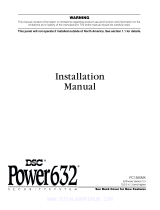Programming Option..............................................................PWS/Desc.
[000] Keypad Function Key Programming.......................................16/33
[001]-[002] Zone Definitions............................................................16/33
[005] System Times ..........................................................................17/34
[006] Installer's Code ........................................................................17/34
[007] Master Code ............................................................................17/34
[009] I/O Programming.....................................................................17/34
[012] Keypad Lockout Options.........................................................17/34
[013] First System Options ...............................................................17/35
[014] Second System Options...........................................................18/35
[015] Third System Options..............................................................18/35
[016] Fourth System Options............................................................18/36
[023] Tenth System Options.............................................................. 18/36
[030] Zone Loop Response Options .................................................19/37
[101]-[134] Zone Attributes..............................................................19/37
[168] Set Clock Forward (Daylight Saving Time)............................20/37
[169] Set Clock Back (Standard Time).............................................20/37
[170] PGM Output Timer..................................................................20/38
[176] Cross Zone/Police Code Timer ...............................................20/38
[190] No Activity Arming Pre-Alert Timer......................................20/38
[191] No Activity Arming Timer...................................................... 20/38
[202]-[206] Zone Assignments.........................................................20/38
[301] First Telephone Number..........................................................20/38
[302] Second Telephone Number......................................................20/38
[303] Third Telephone Number ........................................................20/38
[304] Call Waiting Cancel String......................................................20/38
[310] System Account Code .............................................................20/38
[320]-[322] Alarm Reporting Codes.................................................21/38
[324]-[326] Alarm/Restoral Reporting Codes ..................................21/38
[328] Misc. Alarm Reporting Codes.................................................21/38
[329] Priority Alarm And Restoral Reporting Codes .......................21/38
[330]-[332] Tamper Reporting Codes...............................................22/38
[334]-[336] Tamper Restoral Reporting Codes.................................22/38
[338] Misc. Tamper Reporting Codes...............................................22/38
[339] Closing (Arming) Reporting Codes (Access Codes) ..............22/38
[341] Misc. Closing (Arming) Reporting Codes ..............................22/38
[342] Opening (Disarming) Reporting Codes (Access Codes).........22/38
[344] Misc. Opening (Disarming) Reporting Codes.........................22/38
[345] Maintenance Alarm Reporting Codes.....................................23/38
[346] Maintenance Restoral Reporting Codes..................................23/38
[347] Misc. Maintenance Reporting Codes ......................................23/38
[348] Test Transmission Reporting Codes........................................23/38
[350] Communicator Format Options...............................................23/38
[351] Alarm/Restore Comm. Call Directions ...................................23/38
[359] Tamper/Restore Comm. Call Directions .................................23/38
[367] Opening/Closing Comm. Call Directions ...............................23/38
[375] System Maintenance Comm. Call Directions .........................24/38
[376] System Test Transmission Comm. Call Directions.................24/38
[377] Communication Variables .......................................................24/39
[378] Test Transmission Time of Day...............................................24/39
Programming Option (cont.).................................................. PWS/Desc.
[380] First Communicator Options...................................................24/39
[381] Second Communicator Options ..............................................25/40
[382] Third Communicator Options .................................................25/40
[401] Downloading Options .............................................................25/40
[402] DLS Downloading Telephone Number...................................25/41
[403] Downloading Access Code .....................................................25/41
[404] Panel Identification Code........................................................25/41
[406] Number of Rings to Answer On.............................................. 26/41
[499] Initiate PC Link Downloading ................................................26/41
[501]-[502] PGM Output Attributes.................................................26/41
[600] 2-way Audio Control Options................................................. 27/42
[700] Automatic Clock Adjust..........................................................27/42
[701] First International Options ......................................................27/43
[702] Second International Options..................................................27/43
[703] Delay Between Dialing Attempts............................................27/43
[804] Wireless Programming............................................................28/43
[01]-[32] Wireless Zone Programming.................................... 28/43
[41]-[56] Wireless Key Programming ..................................... 28/43
[60]-[76] Wireless Key Function Key Programming...............28/43
[81] Wireless Supervisory Window......................................... 28/43
[82]-[85] Zone Transmitter Supervision.................................. 29/44
[90] General Wireless Options................................................. 29/44
[898] Wireless Device Enrollment....................................................29/44
[899] Template Programming...........................................................29/44
[900] Panel Version Displayed..........................................................29/44
[904] Wireless Module Placement Test ............................................29/44
[990] Installer Lockout Enable .........................................................29/44
[991] Installer Lockout Disable ........................................................29/44
[996] Restore Wireless Device Default Programming......................29/44
[998] Restore Control Panel Default Programming..........................29/44
[999] Restore System Default Programming....................................29/44
Local Keypad Programming..........................................................30/45
[001]-[034] Zone Label Programming.............................................. 30/45
[065] Fire Alarm Label..................................................................... 31/45
[066] Fail to Arm Event Message.....................................................31/45
[067] Alarm When Armed Event Message.......................................31/45
[068] Command Output #1 Label.....................................................31/45
[069] Command Output #2 Label.....................................................31/45
[074] First Keypad Options .............................................................. 32/46
[075] Second Keypad Options..........................................................32/46
[076] Third Keypad Options.............................................................32/47
[077] Programmed LCD Message ....................................................32/47
[078] Programmed LCD Message Duration.....................................32/47
[201-[234] Door Chime Options....................................................... 32/47
[996] Reset Programmable Labels to Factory Defaults....................32/47




















